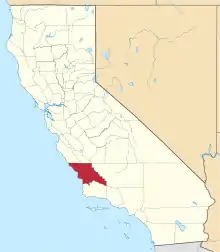Avila Beach, California
Avila Beach (Spanish: Ávila) is an unincorporated community in San Luis Obispo County, California, United States,[3] located on San Luis Obispo Bay[4] about 160 miles (257 km) northwest of Los Angeles, and about 200 miles (320 km) south of San Francisco. The population was 1,576 at the 2010 census. For statistical purposes, the United States Census Bureau has defined Avila Beach as a census-designated place (CDP).[2]
Avila Beach | |
|---|---|
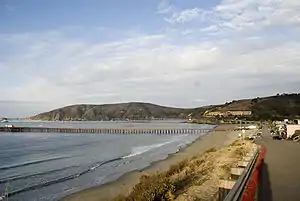 Avila Beach, with Point San Luis at left | |
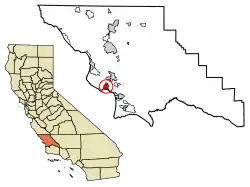 Location of Avila Beach in San Luis Obispo County, California. | |
 Avila Beach Location within the state of California  Avila Beach Avila Beach (the United States) | |
| Coordinates: 35°11′57″N 120°43′15″W | |
| Country | |
| State | |
| County | San Luis Obispo |
| Area | |
| • Total | 6.31 sq mi (16.34 km2) |
| • Land | 6.09 sq mi (15.77 km2) |
| • Water | 0.22 sq mi (0.58 km2) 0.29% |
| Elevation | 430 ft (130 m) |
| Population (2020) | |
| • Total | 1,576 |
| • Density | 258.91/sq mi (99.96/km2) |
| Time zone | UTC-8 (Pacific (PST)) |
| • Summer (DST) | UTC-7 (PDT) |
| ZIP codes | 93424 |
| Area code | 805 |
| FIPS code | 06-03330 |
| GNIS feature ID | 2582937 |
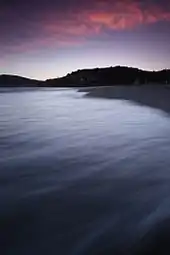
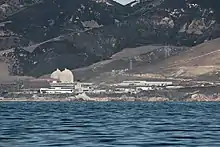
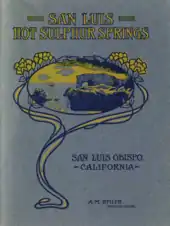
History
The name Avila commemorates Miguel Ávila, who was granted Rancho San Miguelito in 1842.[3][5] The town was established in the latter half of the 19th century, when it served as the main shipping port for San Luis Obispo. Around this time, Luigi Marre built a honeymoon hotel here and steamboats brought customers from San Francisco and Los Angeles.[6]
Although Avila Beach still has a working commercial fishing pier and the inland areas have extensive apple orchards, tourism is now the main industry. There are few historical structures remaining; among the oldest is the Point San Luis Light, built in 1890 after a series of shipping accidents. During World War II the beach and port were used for the Amphibious Training Base Morro Bay.[7]
In the late 1990s, Unocal began the cleanup of decades old oil seepage discovered years earlier from corroding pipes under the township, and which had caused a massive oil spill under the town.[8] Over 6,750 truckloads of contaminated material was sent to a Bakersfield landfill, and replaced with clean Guadalupe Dunes sand.[9] Many of the town's homes and businesses, including several blocks of Front Street, were razed as a result of the quarter-mile-wide excavation. New buildings, homes, businesses, modern walkways and sea motif walls and benches have been constructed.[10]
Geography
The beach is less than 0.5 miles (0.8 km) long and sheltered in San Luis Bay, which is formed by Point San Luis on the west and Fossil Point on the east. Avila Beach faces south and the 600 foot elevation of Point San Luis breaks the prevailing northwesterly winds. It is therefore usually warmer than the other beaches on the Central Coast. Most of Avila Beach is undeveloped, except for a few blocks adjacent to the beach with homes, hotels, and small businesses, and a few upscale housing developments inland near a golf course. Avila Beach is also known for its hot springs, which are used for resort spas.
U.S. Route 101 and State Highway 1 bypass this part of the coastline to the east in favor of a more direct route from Pismo Beach north to San Luis Obispo.
According to the United States Census Bureau, the CDP covers an area of 6.0 square miles (15.6 km2), 99.71% of it land, and 0.29% of it water.
Climate
Average temperatures vary little during the year, ranging from 47–49 °F (8–9 °C) to 70–72 °F (21–22 °C) from November through April, and from 60–69 °F (16–21 °C) to 80–82 °F (27–28 °C) from May through October. Average annual rainfall is 15 inches (380 mm). Along with much of the California coast, winter is the wet season, with more than 70% of the yearly rain falling from December through March, while summer brings drought conditions.
Demographics
| Census | Pop. | Note | %± |
|---|---|---|---|
| 2010 | 1,627 | — | |
| 2020 | 1,576 | −3.1% | |
| U.S. Decennial Census[11] | |||
The 2010 United States Census[12] reported that Avila Beach had a population of 1,627. The population density was 269.9 inhabitants per square mile (104.2/km2). The racial makeup of Avila Beach was 1,507 (92.6%) White, 13 (0.8%) African American, 7 (0.4%) Native American, 33 (2.0%) Asian, 0 (0.0%) Pacific Islander, 34 (2.1%) from other races, and 33 (2.0%) from two or more races. Hispanic or Latino of any race were 111 persons (6.8%).
The Census reported that 1,627 people (100% of the population) lived in households, 0 (0%) lived in non-institutionalized group quarters, and 0 (0%) were institutionalized.
There were 842 households, out of which 115 (13.7%) had children under the age of 18 living in them, 416 (49.4%) were opposite-sex married couples living together, 39 (4.6%) had a female householder with no husband present, 16 (1.9%) had a male householder with no wife present. There were 36 (4.3%) unmarried opposite-sex partnerships, and 14 (1.7%) same-sex married couples or partnerships. 296 households (35.2%) were made up of individuals, and 108 (12.8%) had someone living alone who was 65 years of age or older. The average household size was 1.93. There were 471 families (55.9% of all households); the average family size was 2.45.
The population was spread out, with 183 people (11.2%) under the age of 18, 74 people (4.5%) aged 18 to 24, 263 people (16.2%) aged 25 to 44, 597 people (36.7%) aged 45 to 64, and 510 people (31.3%) who were 65 years of age or older. The median age was 56.9 years. For every 100 females, there were 91.4 males. For every 100 females age 18 and over, there were 92.0 males.
There were 1,093 housing units at an average density of 181.3 per square mile (70.0/km2), of which 529 (62.8%) were owner-occupied, and 313 (37.2%) were occupied by renters. The homeowner vacancy rate was 3.1%; the rental vacancy rate was 7.4%. 1,074 people (66.0% of the population) lived in owner-occupied housing units and 553 people (34.0%) lived in rental housing units.
Points of interest
.jpg.webp)
Avila Beach has three piers: Avila Beach Pier, 1,685 feet (514 m) in length, is open to tourist strolling and recreational fishing;[13] Harford Pier, which is for commercial fishing boats to offload their wares since 1873;[14] and the California Polytechnic State University (Cal Poly SLO) Pier, part of the university's marine research program, is not publicly accessible.
In recent years, the pier has become a site for whale watching as numbers of grays and humpback whales come into bays around the pier to feed and draw crowds during the seasons.[15]
Diablo Canyon Power Plant, the last remaining nuclear power plant in California, is located in a remote part of the Avila Beach unincorporated area, about 6 miles (9.7 km) northwest of the beach itself. In 2016, the owner of the plant, PG&E decided to allow the licenses for two reactors to expire in 2024 and 2025, which would close the power plant.[16][17]
The Avila Beach Pier was featured in a Super Bowl advertisement on February 7, 2010.[18]
Avila Beach was the primary shooting location for the 1979 film California Dreaming, which starred Dennis Christopher, Glynnis O'Connor, and Seymour Cassel.[19][20]
Gallery
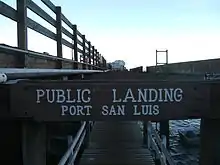 Port San Luis Pier. The pier also has a live fish market and harbor patrol office.
Port San Luis Pier. The pier also has a live fish market and harbor patrol office. Avila Beach and its piers.
Avila Beach and its piers.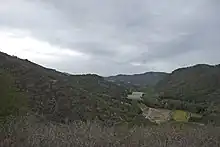 See Canyon in Avila Beach, with apple orchards visible in the distance.
See Canyon in Avila Beach, with apple orchards visible in the distance.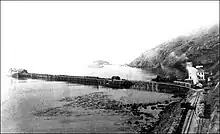 Avila Beach and Harford Pier, late 19th century. Point San Luis and Whaler's Island are visible in the near distance.
Avila Beach and Harford Pier, late 19th century. Point San Luis and Whaler's Island are visible in the near distance. Humpback whale lunge feeding off Avila Beach, 2012
Humpback whale lunge feeding off Avila Beach, 2012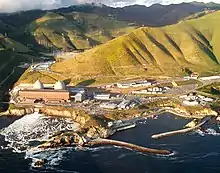 Diablo Canyon Power Plant
Diablo Canyon Power Plant
References
- "2020 U.S. Gazetteer Files". United States Census Bureau. Retrieved October 30, 2021.
- U.S. Geological Survey Geographic Names Information System: Avilla Beach Census Designated Place
- U.S. Geological Survey Geographic Names Information System: Avilla Beach Populated Place
- U.S. Geological Survey Geographic Names Information System: San Luis Obispo Bay
- Durham, David L. (2000). Durham's place names of California's Central Coast: includes Santa Barbara, San Luis Obispo, San Benito, Monterey & Santa Cruz counties. Quill Driver Books. p. 11. ISBN 978-1-884995-29-3.
- David W. Kean, Wide Places in the California Roads: The encyclopedia of California's small towns and the roads that lead to them (Volume 1 of 4: Southern California Counties), p. 19
- Amphibious Training Base Morro Bay
- Paddock, Richard C. (September 28, 1994). "A Long-Buried Oil Spill Casts Beach Town Adrift : Pollution: Unocal is removing tainted soil from Avila Beach, but business district may go with it". Los Angeles Times.
- Martin, Glen (June 8, 1988). "Unocal to Tear Down Toxic Town -- and Rebuild It". SFGate.
- McManis, Sam (July 6, 2014). "Avila Beach remakes itself, from disaster to destination". Sacramento Bee.
- "Census of Population and Housing". Census.gov. Retrieved June 4, 2016.
- "2010 Census Interactive Population Search: CA - Avilla Beach CDP". U.S. Census Bureau. Archived from the original on July 15, 2014. Retrieved July 12, 2014.
- "Avila Pier Closed". Retrieved September 16, 2016.
- "World Port Source - Port San Luis Harbor". Retrieved July 15, 2012.
- Herndon, Kathrene (June 18, 2015). "People flock from all over to check out whales in Avila Beach". KSBY. Archived from the original on October 13, 2015. Retrieved November 11, 2015.
- Gardner, Timothy (November 9, 2021). "Saving nuclear plant could help California hit climate goals -report". Reuters. Retrieved November 10, 2021.
- Katherine Blunt (October 16, 2021). "California Scrambles to Find Electricity to Offset Plant Closures". The Wall Street Journal. ISSN 0099-9660. Wikidata Q114357328. Retrieved October 3, 2022.
- "Behind the Scenes of Bridgestone's Super Bowl Spots". Ad Age. February 7, 2010. Retrieved November 10, 2021.
- Staff report. "Film series to feature movies made in SLO County". Santa Maria Times. Retrieved November 10, 2021.
- Weltner, Anna. "SLOIFF screens films shot in SLO County". New Times San Luis Obispo. Retrieved November 10, 2021.
External links
- Avila Beach Community Services District
- Port San Luis Harbor
- The Point San Luis Lighthouse Point San Luis Lighthouse Keepers
- Central Coast Aquarium - Avila Beach
